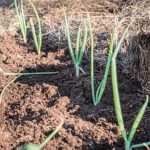Is lime good for vegetable gardens? The pH level of soil plays a crucial role in the health and success of a vegetable garden. Proper soil pH ensures that plants can access essential nutrients, promotes beneficial microbial activity, and affects the availability of minerals. In this article, we will explore the use of lime in vegetable gardens and its impact on soil pH.
Understanding what lime is and how it can benefit vegetable gardens is essential for any gardener. Lime is a soil amendment made from ground limestone or calcium carbonate. It is commonly used to raise the pH level of acidic soils, making them more alkaline. This process can help neutralize soil acidity and create an environment where plants can thrive.
Incorporating lime into a vegetable garden offers numerous benefits, from improved nutrient availability to enhanced soil structure. By raising the pH level, lime can help maintain optimal conditions for plant growth and increase the effectiveness of fertilizers. Additionally, it can aid in reducing toxic levels of aluminum and manganese in the soil, which can be detrimental to plant health. Understanding these benefits is key to harnessing the full potential of lime in a vegetable garden setting.
What Is Lime
Lime is a substance that is often used in gardening to help improve soil quality and provide essential nutrients to plants. It is a versatile product that can be used to adjust the pH levels of soil, neutralize acidity, and provide calcium to the plants. In its natural form, lime is derived from limestone, a sedimentary rock composed primarily of calcium carbonate.
Uses of Lime in Gardening
One of the primary uses of lime in gardening is to raise the pH levels of acidic soil. This helps to create a more favorable environment for plants to thrive, as many vegetables prefer slightly alkaline soil. Additionally, lime can also supply essential calcium to the soil, which is important for plant growth and development. In some cases, lime can also help improve soil structure by reducing the stickiness of clay soils.
Types of Lime
There are several different types of lime that are commonly used in gardening, including agricultural lime, hydrated lime, and dolomitic lime. Each type has its own specific uses and benefits in vegetable gardens. Agricultural lime is the most common type used for raising pH levels in soil and providing calcium to plants.
Hydrated lime is faster acting than agricultural lime but can be caustic if not handled properly. Dolomitic lime contains magnesium as well as calcium and is often recommended for soils that are deficient in magnesium.
When considering whether or not to use lime in a vegetable garden setting, it’s important to understand both the benefits and potential drawbacks of using this product. Knowing how lime impacts soil pH and how it should be properly applied can make a significant difference in ensuring healthy plant growth and bountiful harvests. Ultimately, incorporating lime into vegetable gardens can be beneficial for improving soil quality and creating optimal growing conditions for various types of vegetables.
Benefits of Using Lime
Lime is an essential additive in vegetable gardens due to its numerous benefits. Incorporating lime into the soil can greatly improve the health and productivity of your vegetable plants. Here are some of the key benefits of using lime in your vegetable garden:
- Improves Soil pH: One of the primary benefits of using lime is its ability to raise the pH levels of acidic soil. This is important for vegetable gardens as most vegetables thrive in slightly alkaline soil conditions. Proper pH levels allow for better nutrient absorption by the plants, leading to healthier and more productive crops.
- Provides Essential Nutrients: In addition to adjusting soil pH, lime also supplies essential nutrients to the soil, particularly calcium and magnesium. These nutrients are crucial for healthy plant growth and development, as they support root development and overall plant vigor.
- Enhances Soil Structure: Lime helps to improve the structure of clay soils by breaking up compacted particles, allowing for better water infiltration and root growth. It also helps to counteract the effects of aluminum toxicity in acidic soils, promoting a healthier environment for plant roots.
Incorporating lime into your vegetable garden can lead to numerous benefits such as improved soil pH, enhanced nutrient availability, and better soil structure. It is important to note that while there are many advantages to using lime in your garden, it is crucial to use it judiciously and in accordance with soil test recommendations. Overapplication of lime can lead to excessively high pH levels, which can be detrimental to plant health.
When considering whether or not to use lime in your vegetable garden, it’s important to weigh the potential benefits against any possible drawbacks. Ultimately, if used correctly and in moderation, lime can be a valuable tool for improving the overall health and productivity of your vegetable garden.
How Lime Affects Soil pH
Lime is a common additive to vegetable gardens that gardeners often use to adjust the pH levels of their soil. The pH level of soil is an important factor in the health and success of a vegetable garden. Soil pH measures the acidity or alkalinity of the soil on a scale from 0 to 14, with 7 being neutral. Most vegetables prefer a slightly acidic soil with a pH range of 6.0 to 6.8 for optimal growth.
When lime is applied to the soil, it works to raise the pH level, making the soil less acidic and more alkaline. The primary component of lime is calcium carbonate, which reacts with water and releases hydroxide ions into the soil. These hydroxide ions then react with hydrogen ions in the soil, neutralizing them and reducing the overall acidity.
By increasing the pH level of acidic soils, lime helps improve soil structure and enhances nutrient availability for plants. This can lead to healthier vegetable plants with better root development, improved nutrient uptake, and increased overall yield.
However, it’s important for gardeners to note that adding too much lime can result in excessively high pH levels, which may cause nutrient deficiencies in plants. Therefore, it’s crucial to test the soil before applying lime and only add it when necessary based on the test results.
| Benefits | Details |
|---|---|
| Improves soil structure | Lime helps stabilize clay soils and increases drainage in heavy soils |
| Enhances Nutrient Availability | Lime makes essential nutrients like nitrogen, phosphorus, and potassium more available to plants |
| Promotes Healthy Plant Growth | By adjusting the pH level of acidic soils to a more suitable range for vegetables, lime contributes to healthier plant growth leading to increased yield. |
Types of Lime
In vegetable gardening, soil pH is crucial for the health and productivity of the plants. One common way to adjust soil pH is by using lime. But not all limes are created equal, and it’s important to know the different types and their specific uses.
One type of lime is agricultural lime, also known as aglime or garden lime. This type contains mostly calcium carbonate and is used to neutralize acidic soils. It helps to raise the pH levels, making the soil more alkaline and suitable for a wide range of vegetables. Agricultural lime is typically applied in the fall or early spring to allow enough time for it to break down and react with the soil.
Another type of lime is dolomitic lime, which contains both calcium carbonate and magnesium carbonate. Dolomitic lime is recommended for soils that are low in magnesium, as it can help correct nutrient deficiencies while also adjusting the pH levels. This type of lime can be particularly beneficial for vegetables like tomatoes, peppers, and potatoes that require higher levels of magnesium for optimum growth.
Lastly, there is also hydrated lime, which is fast-acting and has a high neutralizing value. However, it should be used with caution as it can rapidly change soil pH if over-applied. Hydrated lime is best suited for situations where rapid results are needed, but its use should be carefully monitored to prevent negative effects on plant growth.
| Type of Lime | Specific Uses |
|---|---|
| Agricultural Lime (Calcium Carbonate) | Neutralize acidic soils; Raise pH levels; Suitable for a wide range of vegetables |
| Dolomitic Lime (Calcium/Magnesium Carbonate) | Correct magnesium deficiencies; Adjust pH levels; Beneficial for tomatoes, peppers, potatoes |
| Hydrated Lime | Fast-acting; High neutralizing value; Over-application can rapidly change pH levels |
Application of Lime
When it comes to applying lime in a vegetable garden setting, it’s crucial to follow the proper steps to ensure that it is done correctly. The application of lime can greatly benefit the soil pH and overall health of your vegetable garden, but it must be done with care and attention to detail.
Here is a detailed guide on how to properly apply lime in your vegetable garden:
1. Test the Soil: Before applying any lime, it’s important to test the pH levels of your soil. This will help determine how much lime is needed and what type of lime is best suited for your specific soil conditions.
2. Choose the Right Type of Lime: There are different types of lime available, including dolomitic lime and calcitic lime. Each type has its own unique benefits and applications, so be sure to choose the one that is most suitable for your soil needs.
3. Calculate the Amount Needed: Once you have determined the type of lime needed based on your soil test results, calculate the amount required for your vegetable garden area. It’s important not to over-apply or under-apply lime, as this can have negative effects on plant growth.
4. Apply Evenly: When applying lime to your vegetable garden, spread it evenly across the entire area using a rake or spreader. This will help ensure that all parts of the soil receive an equal amount of lime for consistent pH levels.
5. Mix into Soil: After applying lime, gently mix it into the top few inches of soil using a shovel or rake. This will help incorporate the lime into the soil where it can begin to adjust pH levels effectively.
Following these steps will help you properly apply lime in your vegetable garden, promoting optimal pH levels and creating an ideal environment for healthy plant growth.
By following these guidelines on properly applying lime in a vegetable garden setting, you can ensure that your plants thrive in a well-balanced environment with optimal pH levels. Whether you are growing tomatoes, lettuce, peppers or any other vegetables, maintaining proper soil pH is crucial for their overall health and productivity.
Common Mistakes to Avoid
When incorporating lime into vegetable gardens, it’s important for gardeners to be aware of common mistakes that can negatively impact the effectiveness of this soil amendment. Understanding these potential pitfalls can help ensure that the use of lime leads to improved soil pH and healthier plants.
Overapplication
One common mistake gardeners make when using lime in their vegetable gardens is overapplication. Adding too much lime can raise the soil pH to levels that are too high for most vegetables, which can lead to nutrient deficiencies and poor plant growth. It’s important to follow recommended application rates based on soil test results to avoid this issue.
Not Testing Soil pH
Another mistake is not testing the soil pH before applying lime. Without knowing the current pH level of the soil, it’s difficult to determine if lime is actually needed. If the soil pH is already at an optimal level for vegetable growth, adding more lime could disrupt the balance and cause problems for plants.
Ignoring Other Nutrient Levels
Gardeners should also avoid overlooking other nutrient levels in the soil when using lime. While lime can help with managing soil pH, it doesn’t address other nutrient deficiencies that may be present. Conducting a comprehensive soil test and addressing any specific nutrient needs alongside adjusting the pH with lime is crucial for overall plant health and productivity.
By being mindful of these common mistakes, gardeners can effectively utilize lime in their vegetable gardens to create a balanced and fertile growing environment for their crops.
Conclusion
In conclusion, it is evident that lime can be incredibly beneficial for vegetable gardens. By raising the pH levels of acidic soil, lime helps to create an optimal environment for plant growth and nutrient uptake. The use of lime in vegetable gardens can result in improved soil structure, better crop yields, and healthier plants overall. Additionally, the different types of lime available allow gardeners to customize their approach based on their specific soil needs.
When considering whether or not to use lime in a vegetable garden, it is essential to conduct a soil test to determine the current pH levels. This will provide valuable information on how much lime is needed and which type would be most effective. Gardeners must also be mindful of the potential mistakes discussed earlier, such as overapplication or using the wrong type of lime.
Ultimately, when used correctly and in moderation, lime is a valuable tool for maintaining healthy soil in vegetable gardens. Its ability to balance pH levels, improve nutrient availability, and promote healthier plant growth makes it a recommended addition to any gardening practice. As with any garden amendment, proper research and consideration should be taken before incorporating lime into a vegetable garden regimen.
Frequently Asked Questions
Which Vegetables Do Not Like Lime?
Some vegetables, such as potatoes, do not thrive in acidic soil and may not like the presence of lime. Other vegetables that prefer more acidic soil, like blueberries and rhododendrons, also do not fare well with lime.
When Should I Add Lime to My Vegetable Garden?
Lime can be added to your vegetable garden when the soil pH is too acidic. A soil test can determine if your garden needs lime to raise the pH level. It’s best to add lime in the fall or early spring before planting.
Is Lime Good for Tomato Plants?
Lime can benefit tomato plants by raising the pH level of acidic soil, making essential nutrients more available to the plants. However, it’s important not to overdo it with lime as tomatoes prefer a slightly acidic soil. Therefore, always test your soil before adding any amendments like lime.

If you’re looking to get into vegetable gardening, or are just looking for some tips on how to make your current garden better, then you’ve come to the right place! My name is Ethel and I have been gardening for years. In this blog, I’m going to share with you some of my best tips on how to create a successful vegetable garden.





